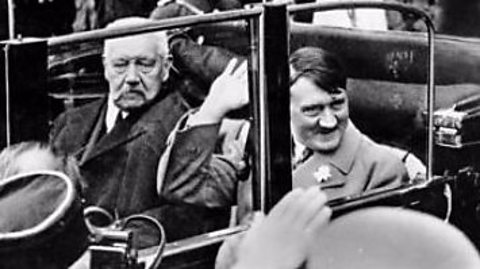Murder on an industrial scale
The discovery of Nazi concentration camps towards the end of WW2 revealed the full horror of Hitler's plans to exterminate Europe's Jews and other minorities. The media reports of the systematic slaughter shocked the world.
What happened in Germany to lead to these events? And how much was known about the mass murders during the years that led to one of the darkest chapters of the 20th Century?
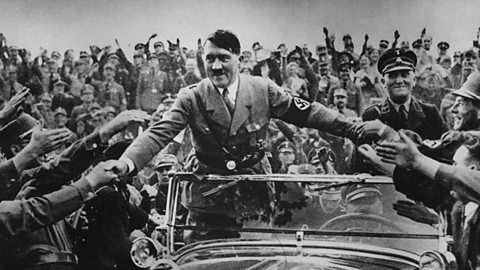
1933
Nazis in power
In January, Adolf Hitler was appointed Chancellor of a coalition government, his own National Socialist party being the largest in parliament.
Hitler quickly moved to cement his power by suspending many civil liberties and allowing imprisonment without trial. By March, the first Nazi concentration camp was established at Dachau, not to imprison Jews but to hold political dissidents. Further laws targeted Jews, restricting the jobs they could hold and revoking their German citizenship. Anti-Semitic sentiment increased as the Jewish population was blamed for many of Germany's recent and historical problems.

1934
Hitler declared F├╝hrer
By August, HitlerÔÇÖs grip on power was secured after a bloody purge that destroyed all opposition in the party. He declared himself F├╝hrer, or leader.
His grip on German society tightened and those who publicly objected to Nazi policies were often sentenced to hard labour in the rapidly expanding concentration camp system. Jews were subjected to further laws restricting their rights, but rising anti-Semitism in Europe wasnÔÇÖt limited to Germany. In the UK, Oswald MosleyÔÇÖs British Union of Fascists gained support from sections of the public and press, even filling the Royal Albert Hall in April.
In a speech broadcast on ┤¾¤¾┤½├¢ radio in November 1934, Churchill warned of the Nazi ÔÇÿgospel of intolerance and racial pride'.
1934 Hitler declared F├╝hrer: video transcript
Churchill's voice:
After all my friends, only a few hours away by air there dwells a nation of nearly 70 million of the most educated, industrious, scientific, disciplined people in the world who are being taught from childhood to think of war as a glorious exercise and death in battle as the noblest fate for man.
There is a nation which has abandoned all its liberties in order to augment its collective strength. There is a nation with all its collective strength and virtue is in the grip of a group of ruthless men preaching a gospel of intolerance and racial pride unrestrained by law, by parliament or by public opinion.
In that country all pacifist speeches, all morbid war books are forbidden or suppressed and their authors rigorously imprisoned. From their new table of commandments they have omitted ÔÇÿthou shalt not killÔÇÖ.
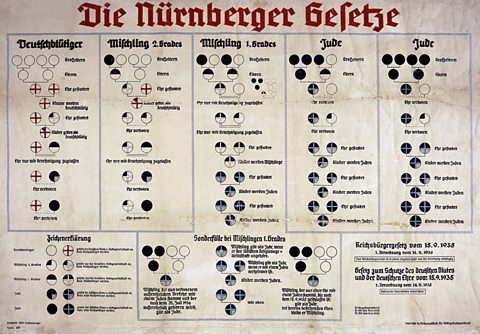
1935
Anti-Semitism as law
In September, policy escalated. The Nuremberg Laws reduced Jews to second-class citizens because of their 'impure' blood.
Defined by the religion of their grandparents rather than by their own beliefs, Jews were viewed as having impure blood lines. The new laws were taught in schools, cementing anti-Semitism in German culture. Most Germans kept quiet, often benefiting when Jews lost jobs and businesses. Persecution of other minorities also escalated: the police were given new powers to arrest homosexuals and compulsory abortions were administered to women considered to be ÔÇÿhereditarily illÔÇÖ.

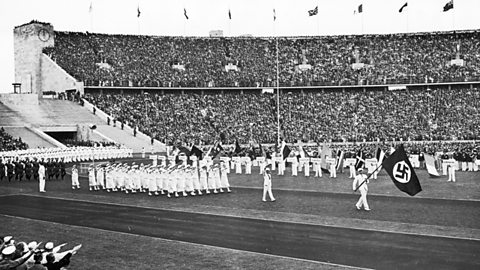
1936
The Third Reich on show
Hitler's anti-Semitic rhetoric had turned many Germans against the Jews. But a different propaganda strategy was needed for a global audience.
The Summer Olympics in Berlin gave the Nazis a platform to project a crafted image to the world. Despite calls for boycotts, the games were a success. Anti-Jewish notices were removed and German spectators cheered black athlete Jesse Owens to four gold medals. Visitors saw a tolerant Reich. However, three days after the games ended, the head of the Olympic Village, Wolfgang F├╝rstner, killed himself as he would soon be dismissed due to his Jewish ancestry under the Nuremberg Laws.


1937
Escalation of anti-Jewish propaganda
As the worldÔÇÖs eyes were on the battle between Fascism and Communism in Spain, the Nazis stepped up their erosion of civil rights in Germany.
Concentration camps began to incarcerate ÔÇÿhabitual criminalsÔÇÖ in addition to political prisoners. Goebbels stepped up anti-Semitic propaganda with a traveling exhibition which cast Jews as the enemy. Nearly half a million people attended. Some guessed worse would come. Winston Churchill criticised British relations with Germany, warning of ÔÇÿgreat evils of racial and religious intoleranceÔÇÖ, though many colleagues complained of his ÔÇÿharping onÔÇÖ about Jews.

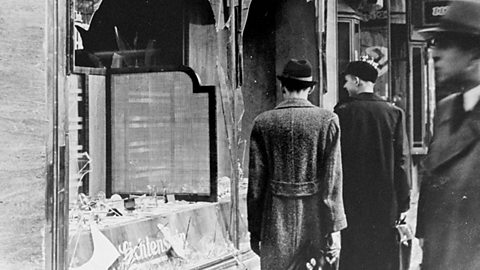
1938
Jewish persecution intensifies
In March, Germany invaded Austria and by September parts of Czechoslovakia too, drawing new territories under the regime of Nazi persecution.
In November, attacks erupted against Jewish businesses. At least 91 Jews died and 267 synagogues were destroyed in a centrally coordinated plot passed off as spontaneous violence across Germany. Thousands of Jews were sent to concentration camps and were only released if they agreed to leave the Nazi territory. Many Jews decided to flee, though options were limited. Britain agreed to house Jewish children, eventually taking in 10,000 minors, but refused to change its policy for Jewish adults.

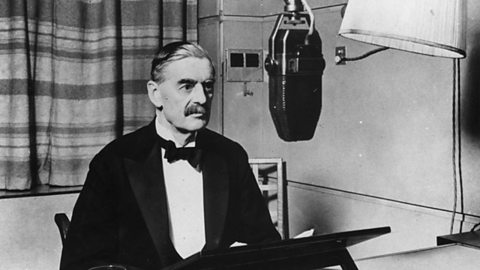
1939
The world at war
Until this point, Nazi strategy had concentrated on getting Jews to leave the Reich but when war broke out in September a different plan emerged.
By the end of September, the SS had started to develop plans to deport Jews to newly invaded Poland: the first steps towards the systematic murder that would follow. In Poland itself, thousands of Poles and Jews were rounded up and shot, early indications of the systematic murder that would follow. Alongside this, Hitler approved a new programme of euthanasia to exterminate the handicapped and mentally ill.

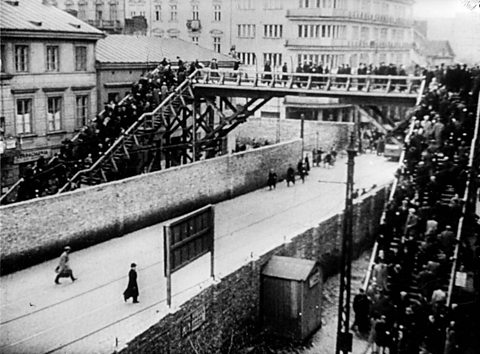
1940
Nazi persecution across Europe
German forces marched across Europe. Of the occupied countries, some capitulated and implemented Nazi policy immediately. Others held off for longer.
For the first time, camps were created specifically for Jews. Their conditions were far worse than other camps. The implicit intention was that the inmates would die there. Increasing numbers of Jews in Poland were relocated in ghettos. Non-Jewish Poles were also deported from their farms and villages to make room for ÔÇÿpureÔÇÖ ethnic Germans to populate the new territory.

1941
The ÔÇÿFinal SolutionÔÇÖ agreed
The Nazi policy on Jews moved from expulsion to containment to commanders being ordered to systematically murder the Jews of Europe.
Methods of mass murder evolved at local levels as well as being decreed from Nazi high command. Killing squads rounded up and shot entire Jewish communities. Over two days in Kiev, 33,771 Jews were shot. The murder of Jews rapidly escalated, in part because local Nazi leaders didnÔÇÖt have enough room to place them in the ghettos. By the end of the year, plans to implement the systematic slaughter of Jews by using gas in mobile trucks and gas chambers were well underway.
A former inmate describes his experiences in a concentration camp. This clip contains disturbing content.
1941 The ÔÇÿFinal SolutionÔÇÖ agreed: audio transcript
I was sitting in a restaurant in Frankfurt and and I spoke to a medical friend of mine about all things I had seen. Hitler must be the biggest murderer in the world now had been overheard by informers of the Gestapo. They rang through to the headquarters and a couple of minutes later I was arrested and the men marched me down to a huge hall in Frankfurt.
I saw already arrested the previous hours before nearly 4000 men of all ages ÔÇô men from 60, 70, 80 years old; and as well boys from 13, 14 and 15 years old.
We had to go on now to climb on lorries and they brought us to the concentration camp about a 1000 feet high. We stood in front of the door got the order march into it, ran into it or perish you swine and again in a panic the men were running for their poor lives.
And about 10 oÔÇÖclock now the Gestapo came in to collect men for murdering just like swine. They took the men out into the night and now you could hear exactly the same as in the tunnels the smashing of beams and of batons, crying of the men and moaning until next day before they died ÔÇô that was our second night in the camp.
And so we had to work very hard. Two men had always to carry stones. And when they collapsed on the way they were hit, they again carried a hundred weight of stones and again they felt always the whip.
Aim to the middle of December the thermometer went deep under the freezing point. The men - no shoes and boots anymore; running around in snow and in ice in bare feet and it happened they got frozen toes and fingers and now a couple of doctors and myself we started to operate the men with razor blades. With razor blades we cut off toes and fingers to save the life of the men. And for bandage we had to use the dirty shirts of the men who died the hours before so done 1939.
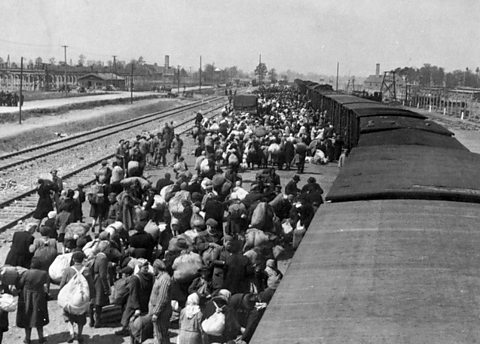
1942
Mass murder
More Jews were murdered in 1942 than in any other year of the Holocaust, the majority in the newly created extermination camps.
Of the 430,000 sent to the first death camp at Bełżec in Poland, there were only two survivors. 700,000 were killed at Treblinka in just five months. In July, Himmler ordered that all Jews in key areas of Poland, except for those needed for essential labour, were to be killed by the end of the year. Most were. Despite Allied intelligence receiving detailed reports of the mass murders in Europe, the public reaction in Britain was largely a mixture of apathy and disbelief.

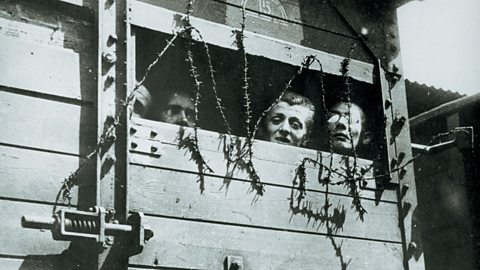
1943
Jewish rebellions
Germany was now losing the war. Vital resources were still ploughed into implementing the 'Final Solution' ÔÇô the extermination of all Jews in Europe.
Uprisings broke out in some extermination camps. The few remaining Jews kept alive to dispose of bodies and sort possessions realised the number of transportees was reducing and they would be next. Civilian uprisings occurred across Poland as mainly young Jews, whose families had already been murdered, began to resist Nazi oppression. With reports of rebellion and mass murder in the British press, the situation in the camps could no longer be ignored.

1944
The long march to Germany
By March, the Allies were driving the German army back.
Tens of thousands of Jews held in the eastern territories were marched towards the heart of Germany so they could not bear witness to the Allies. Aware that the world had been alerted to the horrors of the camps, the Nazis sought to destroy evidence. In June, Soviet forces liberated the first major camp, known as Majdanek, in Lublin, Poland. The Nazis had burned down the crematorium chimney but had failed to destroy the gas chambers and barracks. Only a few hundred inmates were still alive.
Gita Carthagena describes what it was like to be in Auschwitz. Recorded in 1945. This clip contains disturbing content.
1944 The long march to Germany: audio transcript
IÔÇÖve been in concentration camps for three years. I came to the ghetto and then after 15 months we left for Auschwitz. It was the worst concentration camp I ever saw. I have been to several concentration camps ÔÇÿtil now.
In Auschwitz millions of our people were killed by gas. They had different methods ÔÇô but gas was the easiest one. When we came there 5000 of our people had been there for six months and the exact date when the six months were fulfilled they went to the gas. From the day of this we knew the date of our death. I myself was making marks on my bedstead how many days I had to live still. And every night I went to sleep I undercut one mark and so it was one day gone and one day less to live.
The first months I hoped there would be a miracle. The second month we thought ÔÇÿwhy ÔÇô all the people before us went to gas why we not ÔÇô itÔÇÖs our fate ÔÇô you canÔÇÖt change anything on that.ÔÇÖ Then when you are young, I am 21, you want so terribly to live and you never know what value life has got than when you lose it, the exact date. But the people who had the little children were under terrible condition. These little children of six years knew by hearsay that they were going to be exterminated. And they went to their mothers and said ÔÇÿListen mummy you wonÔÇÖt leave me, youÔÇÖll stay with me.ÔÇÖ And most of them stayed with the children and went to the gas; but some of them loved life more than their children and made up their mind to leave them.
1945
Horrors revealed
As the Allies swept to victory in Europe and camps were liberated across the once Nazi-occupied territories, the full scale of the Holocaust emerged.
The Allies found camps that were catastrophically over-crowded with no food or sanitation. General Eisenhower ordered careful documentation of evidence by occupying troops as thoughts turned to justice. Hitler and other senior Nazis including Himmler and Goebbels killed themselves. In November, trials of captured Nazi leaders began at Nuremberg.
Richard Dimbleby reports on the liberation of Belsen for the ┤¾¤¾┤½├¢. This clip contains disturbing content.
Here over an acre of ground lay dead and dying people. You could not see which was which except perhaps by a convulsive movement or the last quiver of a sigh from a living skeleton too weak to move. The living lay with their heads against the corpses and around them moved the awful ghostly procession of emaciated, aimless people with nothing to do and no hope of life. Unable to move out of your way, unable to look at the terrible sights around them.
There was no privacy, nor did men or women ask it any longer. Women stood and squatted stark naked in the dust trying to wash themselves and to catch the lice on their bodies. Babies had been born here ÔÇô tiny wizened things that could not live. A mother driven mad screamed at a British sentry to give her milk for her child and thrust the tiny mite into his arms and ran off crying terribly. He opened the bundle and found the baby had been dead for days. This day at Belsen was the most horrible of my life.
1946
Justice at Nuremberg
The international military tribunal delivered its verdict on 21 senior Nazi officials. 18 were found guilty and three were acquitted.
11 of HitlerÔÇÖs deputies were given death sentences, including Goering, the most senior surviving Nazi. However he too committed suicide the night before he was due to hang. Others received prison terms. Albert Speer, Hitler's personal architect, was released in 1966 and spent his remaining years writing about the Nazi regime, donating most of his royalties to Jewish charities. Rudolph Hess committed suicide in prison in 1987. Many Nazis evaded justice altogether and were never tried.
Extracts from Lord Shawcross's final speech for the prosecution at the Nuremberg trials
1946 Justice at Nuremberg: audio transcript
Twelve million murders; two thirds of the Jews in Europe exterminated; more than 6 million of them on the killersÔÇÖ own figures. Murder conducted like some mass production industry in the gas chambers and ovens of Auschwitz, Dachau, Treblinka, Buchenwald, Mauthausen, Majdanek and Oranienburg.
For such crimes these men might well have been proceeded against by summary executive action and had the treatment which they had been parties to meeting out against so many millions of innocent people been meeted out to them they could hardly have complained. But this tribunal is to adjudge their guilt not on any moral or ethical basis alone but according to law. That natural justice which demands that these crimes should not go unpunished at the same time insists that no individual should be punished unless patient and careful examination of the facts shows that he shared the guilt for what has been done.
And so during these many months this tribunal has been investigating the facts and has now to apply the law in order both that justice may be done to these individuals as to their countless victims and also that the world may know that in the end the predominance of power will be driven out and law and justice shall govern the relations between states.
Learn more about this topic:
WW2: How did one Englishman save 669 children from the Holocaust? document
The story of Sir Nicholas Winton, the 'British Schindler' who saved 669 children from the Holocaust in World War Two.
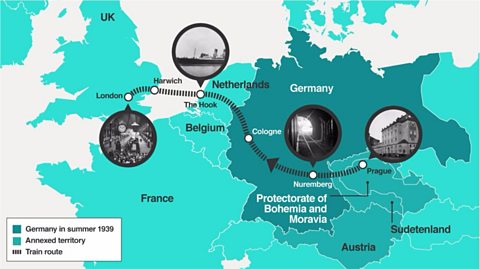
What were conditions like at Auschwitz? video
Dan Snow introduces a short film about the brutal conditions faced by people at Auschwitz, including testimony from a survivor.
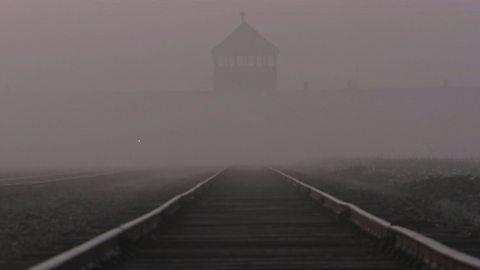
Adolf Hitler: Man and monster. document
Few names from history inspire such immediate and emphatic revulsion as that of Adolf Hitler. His hands are stained with the blood of millions killed in the devastation of World War Two and the horror of the Holocaust. Find out about Hitler's life and discover the road that led to destruction.
